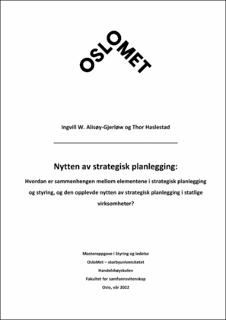| dc.description.abstract | State agencies are required to develop strategies, and management parameters to follow up the strategy and measures implemented. This thesis examines the effect of elements of strategic planning and management, on the perceived usefulness of strategic planning in state agencies. We focus on the following elements: formal strategic planning, gradual adaption of the strategy (“logical incrementalism”), the relationship between performance management and strategic planning, the use of planning elements, stakeholder involvement, and finally the relationship between budgeting, allocation of resources and strategic planning. Also, we have explored the agencies level of strategic management, using a four-level model.
The theoretical foundation in the thesis is based on strategy theory and previous empirical research on the development of strategic planning and management in the public sector. The survey is based on a theoretical framework and survey developed for municipalities, which has been adapted and sent to state agencies. The thesis is a cross-sectional study, where we use secondary data. In total, the survey was sent out to the entire population of directorates, state agencies and universities and university colleges. Fifty-one companies responded to the survey, which gave a response rate of 55 percent.
Using regression analysis, we have mapped how our dependent variable, perceived usefulness of strategic planning, varies against one or more independent variables. The chosen model explains 36 percent of the change in perceived usefulness of strategic planning and the result is statistically significant. The variable with the highest correlation with perceived usefulness, is internal participation in the organization. This is also statistically significant. The second highest correlation has the variable goals and plans. However, this is not statistically significant. The variable logical incrementalism has a negative correlation and is also not statistically significant. The other variables have a low correlation to perceived usefulness of strategic planning and are also not statistically significant. Within the variable internal participation in the organization, it is the senior managers who have the greatest correlation in this model, followed by other managers. Both are statistically significant.
The analysis of how many companies have used a comprehensive strategic management method showed that all the state agencies had developed strategic plans beyond the statutory plans. 17 of the agencies have satisfied all four levels, which is 33 per cent of all the state agencies that have answered the survey. This indicates that strategic planning is widespread among state agencies. | en_US |
